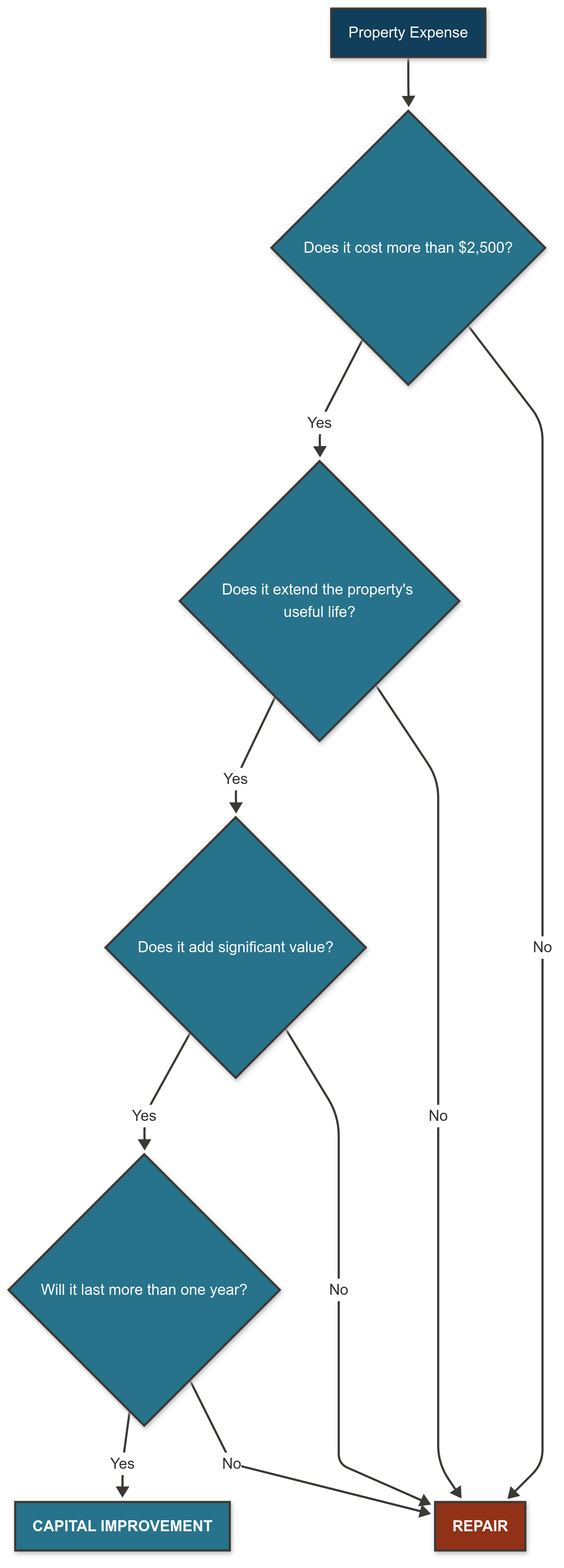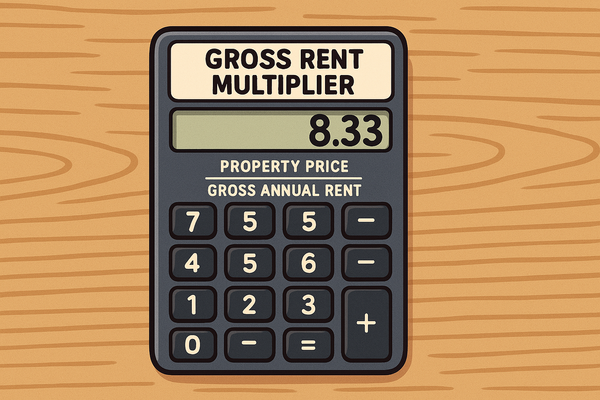Capital Improvements in Property Management: Maximizing Value and Tax Benefits
A capital improvement is defined as a permanent structural alteration, restoration, or enhancement to a property that increases its value, extends its useful life, or adapts it to new uses

A capital improvement is defined as a permanent structural alteration, restoration, or enhancement to a property that increases its value, extends its useful life, or adapts it to new uses. Unlike routine repairs that merely restore functionality, capital improvements represent significant investments that provide long-term benefits to property owners and managers.
For landlords and property managers, understanding the distinction between capital improvements and ordinary repairs is crucial for financial planning, tax strategy, and asset value optimization.
The IRS distinguishes capital improvements from repairs by their longevity (lasting more than one year) and material cost (typically exceeding $2,500).
Properly classified improvements can reduce tax liability through depreciation, increase property valuation, and enhance tenant satisfaction and retention.
In this comprehensive guide, you'll learn how to identify, plan, and implement capital improvements; navigate the legal and tax frameworks governing these investments; and develop best practices that maximize returns while ensuring compliance with regulatory requirements.
A. DEFINITION AND BACKGROUND
What Qualifies as a Capital Improvement?
A capital improvement is a permanent addition or alteration to a property that:
- Adds significant value to the property
- Extends its useful life considerably
- Adapts it to new uses
According to the IRS, capital improvements must be capitalized rather than deducted in the year they occur. These improvements typically involve significant financial investment and provide benefits that last for more than one year.
Capital Improvement Decision Flowchart
Here is a flowchart to help you visualize the process for determining if something is a capital expense or not:

Common examples of capital improvements include:
- Installing a new roof
- Replacing all windows with energy-efficient models
- Adding a room addition or deck
- Renovating kitchens with modern appliances and fixtures
- Upgrading to energy-efficient HVAC systems
- Installing smart home technology
The definition of capital improvements varies across different contexts:
- For residential properties: Focus on amenities like new flooring, kitchen renovations, or bathroom remodels that enhance tenant comfort and property value.
- For commercial properties: Often include structural modifications for ADA compliance, seismic retrofitting, or expanding commercial space to accommodate business growth.
- For municipal properties: Typically involve infrastructure projects like roadway expansions, stormwater management systems, or public park developments with regional impact.
Different institutions may set specific thresholds for what qualifies as a capital improvement. For example, the University of Iowa classifies projects exceeding $100,000 as capital improvements, requiring formal budgeting and oversight processes.
How Capital Improvements Differ from Repairs
Understanding the difference between capital improvements and repairs is essential for proper tax treatment and financial planning:
Capital Improvements vs. Repairs
Understanding the key differences for proper tax treatment and financial planning
| Capital Improvements | Repairs |
|---|---|
| Increase property value | Maintain existing value |
| Extend useful life | Restore normal functionality |
| Adapt to new uses | Keep property in ordinary condition |
| Typically cost >$2,500 | Generally lower cost |
| Must be depreciated | Immediately tax-deductible |
| Examples: new roof, kitchen renovation | Examples: fixing a leaky pipe, repainting |
Note: The IRS distinguishes capital improvements from repairs by their longevity (lasting more than one year) and material cost (typically exceeding $2,500).
B. SIGNIFICANCE IN PROPERTY MANAGEMENT
Financial Impact and Valuation
Capital improvements directly affect a property's cost basis, which is the original purchase price plus the cost of improvements. This adjusted cost basis becomes critical during a sale, as it reduces the taxable gain.
For example, if you purchased a rental property for $450,000 and invested $50,000 in capital improvements, your adjusted cost basis becomes $500,000. If you later sell the property for $600,000, your taxable gain would be $100,000 instead of $150,000.
The IRS requires property owners to depreciate capital improvements over specific timeframes: 27.5 years for residential properties and 39 years for commercial assets. This depreciation can be claimed as a tax deduction, reducing your overall tax liability each year.
Capital Improvements Depreciation Timeline
Example: $12,000 roof replacement on a rental property
Annual deduction: $12,000 ÷ 27.5 = $436/year for 27.5 years
Tenant Relations and Market Value
Well-planned capital improvements can significantly enhance tenant satisfaction and retention. Research indicates that post-improvement retention rates rise by 12% in multifamily properties, particularly when focused on amenities like modernized interiors or energy-efficient systems.
From a market valuation perspective, certain improvements yield exceptional returns. Energy Star-certified upgrades can boost property values by 5–15%, while smart technology installations enhance operational efficiency and appeal to tech-savvy tenants.
Budget Allocation and Priorities
Large property management firms typically allocate 20–30% of their annual budgets to capital improvements, with a strong focus on ROI-driven projects. Unit interior upgrades often deliver the highest ROI in the multifamily sector, with investors spending an average of $5,000 per unit.
For municipal properties, specialized Capital Improvement Programs (CIPs) help forecast infrastructure spending across multiple categories including transportation, utilities, and public safety, typically on a 5-year planning horizon.
C. PRACTICAL APPLICATIONS
Scenario 1: Residential Rental Property Roof Replacement
Situation: A landlord owns a single-family rental home with a 20-year-old roof showing signs of deterioration. Several minor leaks have been repaired over the past two years, but the frequency of repairs is increasing.
Application: Rather than continuing with piecemeal repairs (which would be classified as maintenance expenses), the landlord decides to completely replace the roof—a clear capital improvement with an average cost of $12,000.
Implementation Steps:
- Obtain multiple quotes from licensed roofing contractors
- Select materials that enhance energy efficiency and durability
- Secure necessary permits from local authorities
- Document the entire process with before/after photos, contracts, and receipts
- Properly classify the expense as a capital improvement in accounting records
Outcome: The new roof extends the property's useful life, increases its market value, reduces ongoing maintenance costs, and improves tenant satisfaction. For tax purposes, the landlord deprecates the improvement over 27.5 years, claiming approximately $436 in annual depreciation deductions. Additionally, the new roof's energy-efficient materials may qualify for local utility rebates or tax incentives.
Scenario 2: Multifamily Property Interior Renovation Program
Situation: A property management company manages a 50-unit apartment complex built in the 1990s with dated interiors, experiencing increasing vacancy rates and declining rental income.
Application: The management company implements a strategic capital improvement program focusing on unit interiors, with an average investment of $5,000 per unit.
Implementation Steps:
- Conduct market analysis to identify high-ROI improvements (modern kitchen appliances, updated flooring, energy-efficient lighting)
- Develop a phased implementation schedule to minimize disruption
- Create standardized renovation packages for consistency
- Implement upgrades during unit turnover to avoid displacing current tenants
- Document all expenses and improvements for tax and accounting purposes with streamline rental property management processes
Outcome: Within 12 months, the property experiences a 10% increase in rental rates, a 15% decrease in vacancy, and significant improvement in tenant retention. The ROI exceeds the company's 8% threshold, and the property's overall valuation increases by approximately 12%. The capital expenditure is properly depreciated over 27.5 years, providing annual tax benefits.
Scenario 3: Commercial Property ADA Compliance Upgrade
Situation: A commercial property owner faces potential legal liability because the building's entrance, restrooms, and common areas do not meet current Americans with Disabilities Act (ADA) requirements.
Application: The owner invests in comprehensive ADA compliance upgrades, qualifying as capital improvements due to their permanence and significant cost.
Implementation Steps:
- Hire an ADA compliance specialist to assess the property
- Develop a comprehensive compliance plan
- Install ramps, accessible restrooms, and wider doorways
- Update signage and emergency systems
- Document all modifications for tax purposes and liability protection
Outcome: The property becomes fully ADA compliant, eliminating legal exposure and potentially qualifying for tax incentives specific to accessibility improvements. The upgrades also expand the potential tenant pool and increase the property's marketability. The improvements are depreciated over 39 years (commercial property standard), providing annual tax deductions.
D. LEGAL AND COMPLIANCE CONSIDERATIONS
Federal Guidelines and IRS Regulations
The tax treatment of capital improvements is primarily governed by IRS Code §263(a), which requires capitalization of improvements exceeding $2,500. This regulation distinguishes between deductible repairs and capital improvements that must be depreciated over the property's life.
Property owners must maintain detailed documentation for all capital improvements, including:
- Contractors' invoices and contracts
- Building permits and inspection reports
- Before and after photographs
- Proof of payment
- Depreciation schedules
These records should be retained for at least seven years after the property is sold, as they may be required during an IRS audit. Misclassification of expenses represents a significant risk, with approximately 23% of IRS audits flagging improper coding of repairs as improvements.
State and Local Variations
Regulatory requirements for capital improvements vary significantly by location:
- In Los Angeles, landlords can apply a specific surcharge per unit for a limited time to recoup 50% of improvement costs. For example, a $25,000 exterior painting project split across 24 units would allow for specific monthly rent increases.
- In New York City, the Major Capital Improvement (MCI) program permits landlords to increase rents based on approved improvements, but with strict guidelines and approval processes.
- In California, Title 24 energy standards influence material and design choices for improvements, requiring compliance with specific efficiency benchmarks.
Local building codes, zoning ordinances, and permit requirements must also be followed closely, with non-compliance potentially resulting in fines, project delays, or even forced removal of unauthorized improvements.
E. BEST PRACTICES
1. Develop a Strategic Capital Improvement Plan
Create a comprehensive capital improvement plan that aligns with your long-term investment strategy. This plan should:
- Identify potential improvements based on property condition assessments
- Prioritize projects based on ROI, safety concerns, and compliance requirements
- Establish realistic timelines and budget allocations
- Include contingency funds for unexpected costs
- Align with your annual budget and operating fund strategies
Property management software like Yardi or AppFolio can help track project timelines and budgets, potentially reducing cost overruns by up to 22%.
2. Properly Classify and Document All Improvements
Maintain meticulous records of all capital expenditures to ensure proper tax treatment:
- Create a dedicated filing system for each property
- Take dated photographs before, during, and after improvements
- Retain all invoices, contracts, permits, and payment records
- Consult with a tax professional familiar with real estate to ensure proper classification
- Keep records of contractor communications and project specifications
This documentation is essential not only for tax purposes but also for calculating adjusted cost basis when the property is eventually sold. Consider using tools to estimate property value post-renovation when planning your documentation process.
Capital Improvement Documentation Checklist
Essential records to maintain for tax compliance and financial planning
Use this checklist to ensure you have proper documentation for each capital improvement project. The IRS recommends keeping these records for at least 7 years after the property is sold.
Pre-Improvement Documentation
Regulatory & Approval Documentation
Financial Documentation
Post-Improvement Documentation
Tax Treatment Documentation
Create a dedicated digital folder for each property and subfolders for each improvement project. Store both digital files and scanned copies of physical documents. Consider cloud-based storage with backup for added security and accessibility.
3. Maximize ROI Through Strategic Improvement Selection
Not all improvements deliver equal returns. Focus on high-ROI projects to maximize value:
- Kitchen and bathroom renovations typically return 70-80% of their cost in increased property value
- Energy-efficient upgrades often qualify for tax incentives and rebates
- Security enhancements can justify higher rents and reduce insurance costs
- Curb appeal improvements can significantly increase marketability
Industry benchmarks suggest targeting improvements that achieve at least an 8% return to justify costs. Research your local market to identify which improvements tenants value most in your specific area.
ROI Comparison: Capital Improvements for Property Managers
Data-driven insights to maximize your investment returns
4. Implement Tenant-Centric Improvements
Enhance tenant satisfaction and retention through targeted improvements:
- Conduct tenant surveys to identify desired upgrades
- Focus on amenities that directly impact quality of life (optimize amenity selection for maximum ROI)
- Communicate improvement plans to tenants in advance
- Consider phased implementation to minimize disruption
- Highlight improvements in marketing materials to justify rent increases
Remember that a 12% increase in tenant retention translates directly to reduced turnover costs and vacancy losses.
5. Leverage Technology for Planning and Implementation
Utilize modern technology throughout the capital improvement process:
- Project management software to track timelines and budgets
- Digital twins and IoT-enabled models for predictive maintenance
- Energy modeling software to estimate savings from efficiency upgrades
- Mobile apps for real-time project inspection and documentation
- Cloud storage for organizing and securing improvement documentation
These tools can reduce budget overruns, improve project coordination, and enhance communication between stakeholders.
F. RELATED CONCEPTS
Capital Expenditures (CapEx)
Capital expenditures represent funds used to acquire, upgrade, and maintain physical assets such as property, buildings, or equipment. While all capital improvements are capital expenditures, not all capital expenditures qualify as capital improvements. For instance, purchasing a new building is a CapEx but not an improvement to an existing property.
Understanding the distinction helps property managers develop comprehensive financial strategies that balance immediate needs with long-term investment goals.
Asset Lifecycle Management
Asset lifecycle management involves coordinating improvements with depreciation schedules and maintenance cycles to optimize property performance throughout its usable life. This approach considers the entire lifespan of building components—from installation through replacement—to make data-driven decisions about timing and scope of capital improvements.
By integrating capital improvement planning into a broader asset lifecycle strategy, property managers can extend property longevity while minimizing unexpected costs.
Capital Improvement Programs (CIPs)
Capital improvement programs formalize the planning process for large portfolios or municipal properties. CIPs typically span 5-10 years and include prioritized project lists, funding strategies, and community engagement processes.
For property managers with multiple properties, adopting a similar structured approach enables more strategic allocation of resources and better coordination of improvement projects across portfolios.
Leasehold Improvements
Leasehold improvements are modifications made to rental property by or for a tenant. These improvements become part of the property but are specifically designed to benefit the tenant's business needs. Special tax rules apply to leasehold improvements, with potential benefits for both landlords and tenants when properly structured.
G. COMMON QUESTIONS
How do I determine if an expense is a repair or a capital improvement?
A repair maintains the property in its ordinary efficient operating condition, while a capital improvement materially adds to the property's value or substantially prolongs its useful life. Generally, if the work:
- Replaces an entire structure or system (rather than part of it)
- Adapts the property to a new use
- Significantly upgrades materials or technologies
- Costs more than $2,500
- Lasts more than one year
It's likely a capital improvement. For instance, replacing a broken window pane is a repair, but replacing all windows with energy-efficient models is a capital improvement. Understand key property management terminology for additional guidance on classification.
What documentation should I maintain for capital improvements?
Maintain comprehensive documentation including:
- Dated before and after photographs
- Contractor bids, invoices, and contracts
- Building permits and inspection certificates
- Proof of payment
- Product specifications and warranties
- Depreciation schedules for tax purposes
Store these records in both digital and physical formats, and retain them for at least seven years after the property is sold.
How can I finance capital improvements without depleting cash reserves?
Several financing options are available:
- Dedicated reserve funds (recommended for predictable replacements)
- Home equity lines of credit or conventional loans
- FHA 203(k) loans for residential properties
- SBA loans for commercial properties
- Energy-efficient mortgages for qualifying improvements
- Tax-increment financing for certain commercial developments
Research shows that 62% of small landlords rely on personal savings for improvements, while larger firms typically utilize reserve funds or specialized financing options.
What are the most cost-effective capital improvements for rental properties?
The highest ROI improvements typically include:
- Kitchen modernizations (particularly appliances and countertops)
- Bathroom updates (especially in older properties)
- Energy-efficient HVAC systems
- Smart home technology (security systems, thermostats)
- Flooring upgrades
- Exterior enhancements (roofing, siding, landscaping)
- Boost property value with strategic amenity upgrades
The specific ROI varies by market, property type, and tenant demographics, so research local trends before investing.
CONCLUSION AND RESOURCES
Strategic management of capital improvements represents one of the most powerful tools available to property managers and landlords. By properly identifying, planning, and executing these long-term investments, you can simultaneously enhance property value, improve tenant satisfaction, and optimize tax benefits.
The key to success lies in proper classification, meticulous documentation, and strategic prioritization. Remember that capital improvements are not merely maintenance expenses—they are investments in your property's future that can deliver significant returns when approached systematically.
To continue developing your expertise in capital improvement management, consider these valuable resources:
- Institute of Real Estate Management (IREM) - Offers comprehensive guidelines for capital improvement planning and implementation
- National Apartment Association (NAA) - Provides industry benchmarks and best practices for multifamily properties
- IRS Publication 527: Residential Rental Property - Essential guide to tax treatment of improvements and repairs
- Building Owners and Managers Association (BOMA) - Resources for commercial property improvements and compliance
- Urban Land Institute (ULI) - Research on high-ROI improvements and market trends
By mastering the strategic management of capital improvements, you position yourself to maximize property performance while minimizing tax liability—a winning combination for long-term success in property management.





